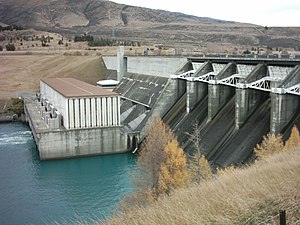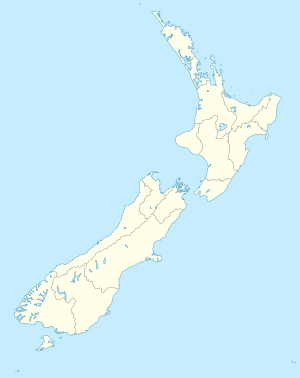Aviemore power station
| Aviemore Hydro Station | ||
|---|---|---|
| Aviemore Hydro Station building and dam | ||
| location | ||
|
|
||
| Coordinates | 44 ° 39 '23 " S , 170 ° 21' 17" E | |
| country |
|
|
| place | Canterbury region , South Island | |
| Waters | between Lake Benmore and Lake Waitaki | |
| power plant | ||
| owner | Meridian Energy | |
| operator | Meridian Energy | |
| construction time | 1962 to 1968 | |
| Start of operation | 1968 | |
| technology | ||
| Bottleneck performance | 220 megawatts | |
| Average height of fall |
37 m | |
| Standard work capacity | 942 million kWh / year | |
| Turbines | Francis turbines 4 | |
| Generators | 4 × 55 MW | |
| Others | ||
| Website | www.meridianenergy.co.nz | |
The Aviemore Power Plant ( Aviemore Hydro Station ) is a run-of-river power plant on the South Island of New Zealand . The power plant is one of eight power plants under the Waitaki Hydro Scheme , a large-scale hydropower project in the Canterbury area .
geography
The power plant is located 75 km southwest of Timaru and 72 km northwest of Oamaru between the reservoirs of Lake Benmore in the northwest and Lake Waitaki in the southeast.
history
The dam project for damming the lake began in 1962. But by the end of the 1950s the settlement of Otematata , which means “place of good flint” in the Māori language , was built. It is still located today on the narrow part on the southwest side of the lake. The site was built for workers building the Lake Aviemore and Lake Benmore dams , and at its peak in 1963, it was home to over 4,000 residents. Many houses were later sold as holiday accommodation.
As of 2020, the Aviemore power plant will be operated by the majority state-owned company Meridian Energy Limited .
Barrier structure
The barrier structure consists of a 56 m high and 364 m long gravity dam made of concrete and a 49 m high and 430 m long earth dam. The concrete wall has a width of 12 m at its base and tapers to a width of 7 m to the crown, over which a road leads. The dam can withstand a water pressure equal to the capacity of the reservoir of at least 530 million m 3 of water. The power plant's machine house is on the southwest side of the dam, and the weir system with the flood relief is on the northeast side . A maximum of 4,500 m³ / s can be discharged via the flood relief.
The construction of the dam as a dam and concrete dam was chosen because on the southwest side of the river rejection of Waitangi Fault crosses the dam structure. The concrete dam could be built on solid rock, while the earth dam was built on the fault.
power plant
The Aviemore power plant has an installed capacity of 220 MW . The average annual production is 942 GWh.
The four machines of the power plant are located in a machine house at the foot of the dam. The four generators, which are driven by Francis turbines , deliver a maximum of 55 MW each at a nominal voltage of 11 kV . The rotor of a generator weighs 210 t and has a diameter of almost 8 m. Both the turbines and the generators were supplied by Siemens .
The fall height is 37 m.
Reservoir
With the completion of the barrier structure, the reservoir called Lake Aviemore was dammed. The lake, which extends over an area of 28.8 km 2 , has an estimated capacity of 530 million m 3 , with a targeted storage target between 265.5 m and 268.3 m.
Earthquake hazard
Geological investigations from the years 2004/2005 showed that the Waitangi Fault became active 13,000, 14,000 and 23,000 years ago and a vertical movement between 0.5 m and 2 m took place in each of these activities.
When adopting an earthquake of magnitude 7 M W resulted in calculations that the dam is indeed have cracks in its core, but these only from a depth of 10 m will result in individual leakage, but without endangering the stability and steadiness of the dam.
See also
Web links
literature
- Lelio Mejia, Ethan Dawson : Analysis of Dam Response for Foundation Fault Rupture . In: Bulletin of the New Zealand Society for Earthquake Engineering . Vol. 42, no. 1 , March 2009 (English, online [PDF; 607 kB ; accessed on January 12, 2020]).
- DJA Barrell, RJ Van Dissen, KR Berryman, SAL Read : Characterization of late Quaternary displacements on the Waitangi Fault at Aviemore Dam, New Zealand . Ed .: Institute of Geological & Nuclear Sciences Ltd . March 2005 (English, online [PDF; 1.3 MB ; accessed on January 12, 2020] paper for a conference).
Individual evidence
- ^ Hydro Stations . Meridian Energy , accessed January 13, 2020 .
- ↑ Topo maps . Land Information New Zealand , accessed January 12, 2020 .
- ↑ a b c d Discover the Waitaki Hydro Scheme . (PDF; 1.9 MB) Meridian Energy , November 2008, archived from the original on February 17, 2011 ; accessed on January 12, 2020 (English, original website no longer available).
- ↑ a b Aviemore hydro station . Meridian Energy , accessed January 12, 2020 .
- ^ Mejia, Dawson : Analysis of Dam Response for Foundation Fault Rupture . 2009, p. 10 .
- ↑ Waitaki Power Stations - Appendix A - Extracts of Waitaki Operating Rules . (PDF 185 kB) PMinistry for Business, Innovation & Employment , November 9, 1990, p. 13 f. , archived from the original on February 23, 2013 ; accessed on June 16, 2015 (English, original website no longer available).
- ↑ Barrell, Van Dissen, Berryman, Read : Characterization of late Quaternary displacements on the Waitangi Fault at Aviemore Dam, New Zealand . 2005, p. 2 f .
- ^ Aviemore Hydroelectric Power Plant New Zealand . Global Energy Observatory , accessed June 12, 2015 .
- ↑ Introducing Aviemore . (PDF 121 kB) Meridian Energy , September 2005, archived from the original on June 15, 2015 ; accessed on June 10, 2015 (English, original website no longer available).
- ^ Lake levels - Lake Aviemore lake levels . Meridian Energy , accessed January 12, 2020 .
- ↑ Barrell, Van Dissen, Berryman, Read : Characterization of late Quaternary displacements on the Waitangi Fault at Aviemore Dam, New Zealand . 2005, p. 1 .
- ^ Mejia, Dawson : Analysis of Dam Response for Foundation Fault Rupture . 2009, p. 11, 17 .

